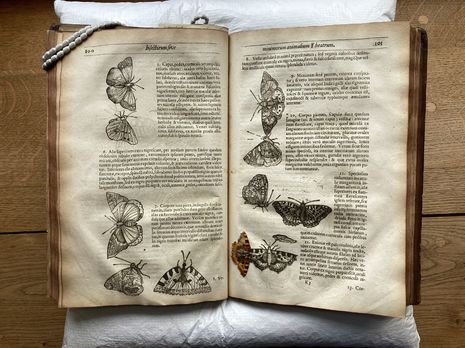Preserved butterfly discovered in 385-year-old book at Trinity Hall’s library
The butterfly, pressed between the book’s pages, could be nearly as old as the book itself, published in 1634

A preserved butterfly has been found pressed between the pages of the ‘Theatre of Insects’ in the Jerwood Library of Trinity Hall college, Cambridge.
The College confirmed in a press release that the insect would have been there since before the book came to be in the Trinity Hall collection in the 1990s. This could date the butterfly’s preservation anytime between 1634, when the book was published, up until the 1990s.
The discovery was made by Jenni Lecky-Thompson, Head of Library Services at the College, who found the small, colourful butterfly next to the black inked 17th Century woodcut image of itself.
The book Theatre of Insects, or Insectorum sive Minimorum Animalium Theatrum, was donated to the College by the family of former Trinity Hall undergraduate Lawrence Strangman who died in 1980. It was the first book to be published in England exclusively discussing insects, covering the appearance, habits and habitats, of what we think of today as insects, as well as arachnids and worms.
When Trinity Hall’s Jenni Lecky-Thompson was looking for an interesting animal book to write a blog post about she discovered a pressed butterfly, beautifully preserved in the folds of England’s earliest insect book. pic.twitter.com/7pvMrDL1Ez
- Trinity Hall (@TrinityHallCamb) March 25, 2021
Lecky-Thompson said of her discovery: “While looking through our copy I chanced upon a butterfly (a small tortoiseshell I think) next to its accompanying image. There is a striking similarity between the woodcut and butterfly, which of course was the intention so that the various species could be identified by the amateur insect enthusiast.”
She added that: “It is relatively common to find botanical specimens inside old books, but unusual to find an insect specimen. This one could have been put there by the first owner back in the 17th century, and if so it is amazing that it has survived there for so long.”
Contemporaries such as James Petiver, a 17th century London apothecary writer, have advised on how to preserve insects, says Lecky-Thompson. Petiver instructed: “Butterflies must be put into your Pocket-Book or any other small printed book as soon as caught.” This simple method could preserve insects for hundreds of years.
 News / Uni Scout and Guide Club affirms trans inclusion 12 December 2025
News / Uni Scout and Guide Club affirms trans inclusion 12 December 2025 News / Cambridge Vet School gets lifeline year to stay accredited28 November 2025
News / Cambridge Vet School gets lifeline year to stay accredited28 November 2025 Science / Did your ex trip on King’s Parade? The science behind the ‘ick’12 December 2025
Science / Did your ex trip on King’s Parade? The science behind the ‘ick’12 December 2025 News / Cambridge study finds students learn better with notes than AI13 December 2025
News / Cambridge study finds students learn better with notes than AI13 December 2025 News / Pembroke to convert listed office building into accom9 December 2025
News / Pembroke to convert listed office building into accom9 December 2025







